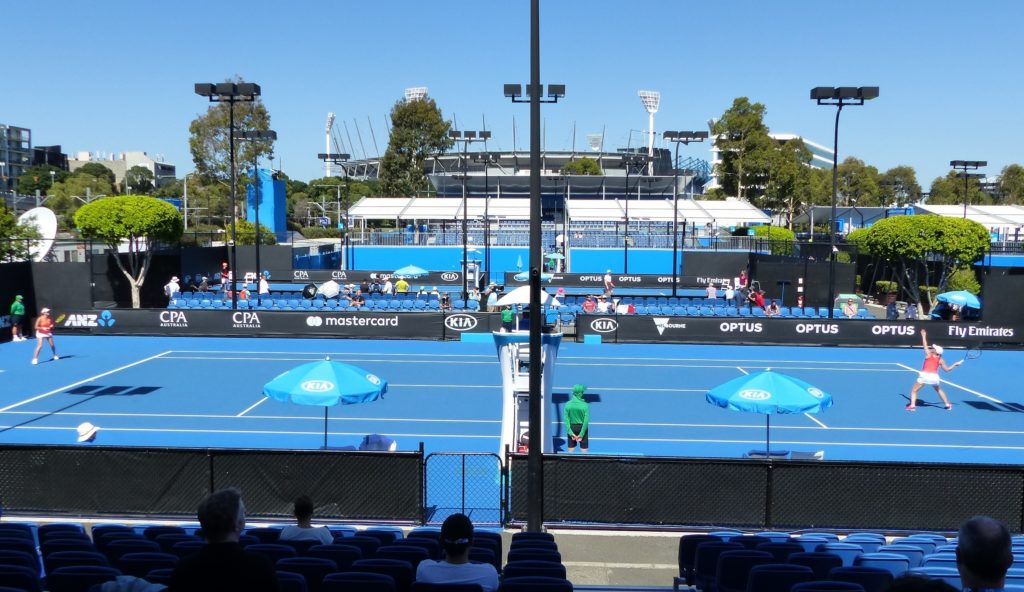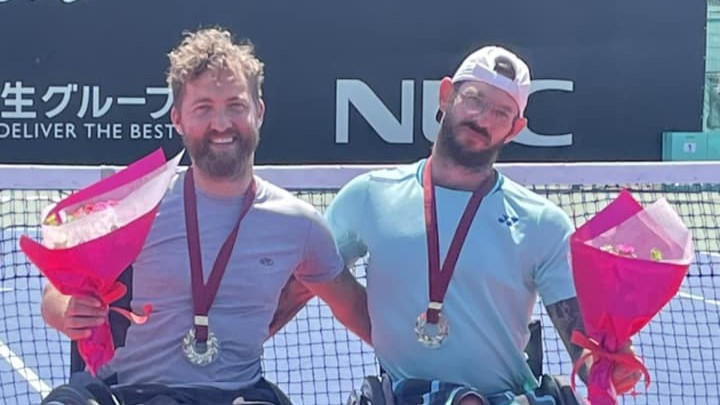
The second day of qualifying at the Australian Open was played under bright skies and moderate temperatures (mid 20s) on Thursday, as can be seen in the picture here from Court 13 where Aleksandra Wozniak (on left) came out on the short end of a 6-4, 6-1 score against Virginie Razzano of France.
Chances for rain of the patchy variety are at 80 per cent for Friday’s third day, and then there’s a forecast of a scorching 38 degrees for next Tuesday, the second day of main draw action.
Precipitation on Friday could cause problems for the draw ceremony, which is to take place at 11 a.m. (7 p.m. Thursday ET in Canada), in front of Margaret Court Arena in an area not totally protected from rain.

With all the focus on the return of Roger Federer, it will be interesting to see where the great Swiss comes out in the draw because he will be seeded No. 17 and slated to play a top-16 seed in the third round. A Swiss journalist looked at the path of last year’s No. 17 seed – Benoit Paire of France – and became pessimistic about Federer’s chances this year. In 2016, Paire, who was upset in the first round, was drawn to play No. 9 seed Jo-Wilfried Tsonga in the third round, No. 7 Kei Nishikori in the round-of-16, No. 1 Novak Djokovic in the quarter-finals, No. 3 Federer in the semifinals and No. 2 Andy Murray in the final.
Of course things could come out much differently this year but, if they did not and Federer has to play (a one in eight chance) the No. 9 seed in the third round, that would mean a potential match-up with old rival Rafael Nadal who’s currently No. 9 in the rankings and seeded ninth.

Novak Djokovic is seeded second and going for his seventh overall Australian Open title, and his sixth in the last seven years.
Pictured above practicing on Thursday, Djokovic will probably be hoping to miss the predicted heat on Tuesday – conditions that he’s never at ease playing in – by either starting out on Monday, or playing at night.
With current No. 39 Juan Martin del Potro, who would have been the event’s most dangerous un-seeded ‘floater,’ not playing in order to rest his vulnerable left wrist, there are few real time bombs outside the 32 seeded players.
Third-seeded Milos Raonic will probably be fairly neutral about whether he comes out in the Murray or Djokovic half with its resulting hypothetical semifinal.
On the women’s side, likely the players most of the top seeds would like to avoid, based on recent form, are No. 37 Katerina Siniakova of Czech Republic, a 20-year-old who just won the WTA event in Shenzhen, China, defeating No. 4-ranked Simona Halep and No. 10 Johanna Konta along the way, as well as No. 48 Belinda Bencic and No. 49 Genie Bouchard.
Serena Williams, trying for her seventh Aussie Open title, but only her second since 2010, has played just two matches since the 2016 US Open. She beat No. 69 Pauline Parmentier of France before losing 6-4, 6-7(3), 6-4 in Auckland last week to fellow American, No. 72-ranked Madison Brengle. A tough first-round opponent – in 2016 she struggled to beat No. 35 Camilia Giorgi 6-4, 7-5 in the opening round before finding form and sailing through five opponents to the final – could be a threat for the 35-year-old Williams.
ABANDA MOVES ON

Canadian women went 1-1 on the second day of qualifying with Francoise Abanda, ranked No. 176, rallying to cruise past No. 290-ranked Aussie wild card Storm Sanders 3-6, 6-2, 6-1 and Wozniak exiting to Razzano.
It was the 22-year-old Sanders’ sixth consecutive year of going 0-1 at the Australian Open – three of those matches were in the main draw and three in the qualifying.
The less said about the match the better. Sanders pretty well lost the plot after the first set, dropping 11 out of the 13 games.
Still Abanda, 19, was pleased with her win. “I was a little nervous at the beginning so I’m happy I was able to turn the match around,” she said.
About next playing 20-year-old Taylor Townsend of the U.S. in the second round on Friday, Abanda said, “she’s another left-handed player (like Sanders) and we were in the juniors together. Taylor has a good serve and plays the angles well. I’ll have to start better than I did today and hit the ball more cleanly.”
Maybe the most memorable match for Abanda against No. 131-ranked Townsend was back in the Wimbledon junior girls doubles event in 2012 when she and her American partner Sachia Vickery were beaten in the semifinals by another Canadian/American duo – Townsend and Genie Bouchard who went on to win the title. That same year Townsend won the Australian Open junior singles while Bouchard triumphed at Wimbledon, with Townsend winding up the year at No. 1 in the International Tennis Federation rankings.
Abanda was quite candid about her feelings about the Australian Open. Unlike most players who adore the event, she said, “honestly it’s the Grand Slam that I like the least. My favourite is the US Open. But I’ve only been here twice. I lost in the first round of the qualifying here two years ago.”

Abanda’s fellow Quebecer Aleksandra Wozniak had a disappointing outing in her opening round of qualifying – exiting 6-4, 6-1 to Virginie Razzano. The match was even up to 4-4 in the first set and then the 33-year-old Frenchwoman played more consistently and aggressively against an increasingly erratic Wozniak. The second set was even more dismal for Wozniak who, post-shoulder surgery, has struggled to find the form that took her to No. 21 in the WTA rankings in 2009. Currently at No. 298, the likeable Montrealer has a major challenge ahead of her trying to recapture the magic that made her one of the tour’s finest ball strikers.
On Friday – both at 10 a.m. (6 p.m. ET Thursday in Canada) – Abanda will take on Townsend in Showcourt 3, the largest stadium used for the qualifying. Peter Polansky, on the other hand, is out in the boonies – Court 19 – for his second-round encounter with Mirza Basic of Bosnia and Herzegovina.
GENIE GETS BEAT

There are times in all sports when a player or a team simply just gets beat. That’s essentially what happened to Genie Bouchard when she was outhit 6-2, 6-2 by Johanna Konta in the Sydney tournament semifinals on Thursday night.
In the very first few games there was a sense that Konta was drilling harder and flatter and deeper than Bouchard but there was also the matter of her maintaining that level. Unfortunately for Bouchard, Konta actually got even better and after 2-2 in the opening set won 10 of the last 12 games with supreme ball striking that had Bouchard off balance and unable to create her own attacking tennis.
Bouchard got a little frustrated but mainly kept her composure, accepting, as best one could tell, that Konta’s fabulous form on the night made it impossible to impose her own tennis.
It’s useful to remember that Konta, two years ago when she was 24 and ranked No. 147, lost in the qualifying final round in Sydney, the city of her birth and where she lived for her first 13 years. Now she is ranked No. 10 and in the final against world No. 3 Agnieszka Radwanska on Friday night.
Bouchard is just 22 and, with a game-style comparable to Konta’s all-out attack, she has plenty of time and room for improvement.
AUSTRALIAN POST CARD

Most television viewers in Canada are familiar with the ‘Trivago man’ in the ads promoting the travel website. In Australia, the ‘Trivago Man’ is actually the ‘Trivago Woman.’
NOTE: Back tomorrow with more qualifying results and thoughts on the 2017 men’s and women’s Australian Open singles draws.


